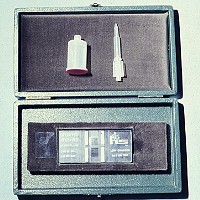Platelet Count
 Unopette® system for platelet counting with Newbauer hemocytometer.
Unopette® system for platelet counting with Newbauer hemocytometer.
|
Platelet counts can be done manually or using
automated cell counters. Since many laboratories use instruments that
count platelets, red cells and leukocytes concurrently, a platelet count
is a routinely reported result on many samples of dog and horse blood.
However, platelet clumping will lower (and in some instances invalidate)
the platelet count when determined by any method. This occurs
especially in samples of cat and cow blood (see image below). In these
instances, an accurate platelet count cannot be provided, but for most
purposes, significant changes in platelet number can be detected during
the microscopic examination of the stained blood smear (see section
on platelet estimation). In such samples, close attention should be
paid to the platelet smear estimate part of our hemogram.
Platelet clumping is usually  due
to a sample collection problem and can be minimized by collecting blood
from a large peripheral vein (cephalic or jugular), such that blood
flows smoothly into the vacutainer or syringe, and using a 22 or 23
g needle (in a dog or cat). The blood should be mixed with the anticoagulant
as soon as possible after collection, by gentle rotation or inversion.
Platelet clumping increases with time, so platelet counts should be
done as soon as possible after collection to maintain accuracy. due
to a sample collection problem and can be minimized by collecting blood
from a large peripheral vein (cephalic or jugular), such that blood
flows smoothly into the vacutainer or syringe, and using a 22 or 23
g needle (in a dog or cat). The blood should be mixed with the anticoagulant
as soon as possible after collection, by gentle rotation or inversion.
Platelet clumping increases with time, so platelet counts should be
done as soon as possible after collection to maintain accuracy.
Manual platelet counts
Platelet counts are done manually using
a Unopette® diluting system, hemocytometer, and a microscope acquipped
with phase microscopy. The platelets can be visualized in the counting
chamber and directly counted, however this method is relatively inaccurate
compared to automated counting. Platelet clumps also invalidate the
count as the platelets cannot be enumerated accurately if they are all
piled up in clumps on the hemocytometer. Since we have the Advia, manual
platelet counts are rarely performed.
Impedance-based platelet
counts
Our old hematology analyzer, the S+IV,
used to count platelets by impedance methods (see RBC count). This is
less accurate than the Advia as debris and small red blood cells are
also included in the platelet count.
Flow cytometry-based
platelet counts
This measures platelets by flow cytometry based on principles
of light scattering.
 |
1. Platelets
2. Large platelets
3. Red blood
cells
4. RBC fragments
5. Debris
6. Ghosts
|
Platelets are identified by their size (< 30 fL) and refractive
index (n = 1.35 to n = 1.40). The platelet cytogram on the left is a
graphical representation of how the Advia counts platelets. Low light
scatter is plotted against the X axis and high light scatter is plotted
against the Y axis (B). Platelets are detected in the region labeled
1. Large platelets (section 2) are identified on the basis of size (>
20 fL) and refractive index (which distinguishes them from red
cells). In species with very small red cells, e.g. goats, some red blood
cells may be counted as platelets.
The analyzer also detects platelet clumps and flags their presence.
When this occurs, a comment is appended to the platelet count or smear
estimate (if a count is not provided) demonstrating the presence of
clumps.
Last Updated: June 2000
|